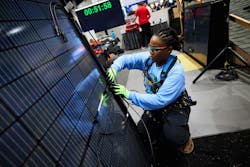Battle Cry from Intersolar: The Ironclad Argument Reinforcing the Strengths of Microgrids, DERs in the Energy Revolution
SAN DIEGO – Optimism was abundant, evidenced in the smiles on faces locked in conversations, swapping project stories and reuniting with distant friends.
The solar and energy storage legs of the race to decarbonize shined in full light during Intersolar/EnergyStorage North America at the San Diego Convention Center this past week. Thousands gathered to reaffirm a common allegiance to advance the clean power generation cause, and most reveled in the chance to connect environmental, humanitarian and business cases for the road to you know where.
There was even the Solar Games competition to show how fast and adept the installation side can operate. Speed is key.
“Reaching net zero as fast as possible is the critical challenge we face,” said Jesse D. Jenkins, the Princeton University assistant professor and macroscale energy systems engineer who spoke at one of the Intersolar keynotes.
“We simply cannot continue with business as usual,” Jenkins added.
He was hardly alone in those sentiments long held within this inclusive circle of true believers. And yet inertia--both of the physical and psychological kind--is a hard thing to overcome or reverse, as most anyone in the electricity and human nature sectors understands. While excitement was elevated at Intersolar, so was some degree of realism as well as concern and commitment to overcoming those ever-present hurdles.
Putting a present value on resiliency for the future
Tailwinds are great, but headwinds are inevitable. For every government incentive or private equity commitment to microgrids, distributed energy resources and decarbonization technologies, there are walls of both passive and active resistance, whether political or fiscal.
Consider the corporate decisions to shut down major investments in offshore wind or fleet electrification lately. Keep in mind that even normally progressive California can step backward , such as the appellate court decision to uphold the California Public Utilities Commission’s NEM 3.0, which revised solar billing policy downward, reducing export rates 75% for solar sold back into the grid to help with capacity issues.
Well, excuse us for trying to make the world a more actively decarbonized and bidirectional place. It’s business, not personal, as they say in “The Godfather.” Nothing bad happens there, right?
Yet many do take it personally. Many gathered at Intersolar were there because they believe one of the crucial movements of modern times is to combat climate change and clean the atmosphere via decarbonization and decentralization of the power grid.
The future looks bright, but reality can be harsh and unmoved by passion or even case-study examples. Businesses may not admit it, but they often prefer business as usual, even if the Earth doesn’t.
“We have to start by valuing resiliency,” noted Jennifer Potter, who led an Intersolar panel and is director of regulatory innovation at clean energy consulting firm Strategen. “That’s rough, because the price is high and benefits are not always known for years.”
Potter outlined a better path to putting a numerical value on resiliency through such factors as the cost of energy not served (the financial damage to airlines when airports go down or to manufacturers when the plant is stilled), customer damages (food spoiled, products impacted) and the willingness to pay for resiliency, which can avert such future negative outcomes.
“Resilience should be in the value stack of anything we are evaluating,” said Potter, who lives in Hawaii and saw the devastation and subsequent microgrid response work in Maui first-hand. The current prioritization is “upside down. Instead of just cost recovery, what if we did performance-based regulation?”
Finding a solution may not be that easy, especially if the equation itself is difficult to ascertain. In a separate keynote panel at Intersolar, Eric Hsieh, assistant secretary for energy storage at the U.S. Department of Energy, wrestled with the notion of defining the values in clean energy and wondered if the market will better inspire a turn-around in priorities.
"I tend to wonder if placing the task of answering what the value of local solar and storage is solely on regulators is too much to ask," Hsieh said. "The Department of Energy has been funding studies on what the value is of these things for well over two decades, and I don't think we've gotten to a satisfactory conclusion.
"My hope is that our overall economic system is durable enough so all of these millions of experiments all over the country and individual communities leads to solutions that are scalable in terms of viable business cases or value propositions that may not be reflected in the market itself," he added.
Stretching the vision of short-term thinking and operational costs
Surely, utilities get dinged for bad power outage metrics such as SAIDI (the System Average Interruption Duration Index). And cost avoidance is valued in forward-thinking, energy-efficiency investment decisions. A penny saved is a penny earned, but a penny pinched can be a wasted opportunity.
The corporate world is sometimes worse at this recognition than even the oft-derided regulators. Experience has taught this to Steve Pullins, chief technology officer at microgrid developer AlphaStruxure and a longtime microgrid expert going back to his days with Schneider Electric. (AlphaStruxure is a joint venture of Schneider Electric and investor Carlyle Group.)
One of the major impediments to an economic decision uniting decentralization and decarbonization of energy is a lack of realization of what a commercial and industrial customer’s reliability issues are costing them, he noted. (Pullins led an airport microgrid panel at Intersolar, but his comments here came earlier to Microgrid Knowledge.)
“While savvy customers have a feel for what the operational challenges cost them in time and lost production amounts, this has not translated well to the C-level in terms of (determining) economic losses to the business,” Pullins pointed out. “A 30-second grid outage that takes a process plant 24 hours to recover or a manufacturing plant that has to clean out their vats of lost product are not analyzed out to the economic impact on the company.”
Indeed, a penny pinched once more converts into a dollar lost. Stretch that equation out exponentially and, boom, you’re talking about real losses here.
Crushing the clay jar of innovation via regulatory inertia
If a CEO or CFO cannot see that, imagine the lack of vision sometimes facing regulators and authorities in jurisdictions trying to decide whether this microgrid or that solar-storage combo should gain interconnection favor. These hems, haws and delays have resulted in billions of dollars of investment pulled.
Jon Norman, CEO of long-duration compressed air energy storage startup Hydrostor, was at Intersolar expressing his excitement about all the progress the company has made in getting projects moving forward in Australia and California. Goldman Sachs and other investors have made a $250 million commitment to what Hydrosor is doing.
Hydrostor offers both a long-duration alternative to lithium-ion and a way to team with other developers to create hybrid systems that combine renewables, combined heat and power efficiencies and microgrid resiliency. The work of such projects as Broken Hill in Australia and Willow Rock in the Mojave Desert of California is proof of concept for both the company and its supporters.
“We couldn’t ask for better partners,” Norman told Microgrid Knowledge at Intersolar.
And yet, particularly in the U.S., regulatory insight is like a spinning wheel of fortune where sometimes you hit the jackpot and sometimes the clay jar of innovation is crushed. In America, it’s 50 different attitudes with 50 different agendas.
And then you also have to deal with regional transmission organizations harboring varying priorities on speeding up interconnection delays.
“What we’ve found is (in some cases) they really haven’t gotten their heads around getting ahead,” Norman said. “That is really frustrating.”
Resource adequacy and staying on the sunny side
Even the utilities – sometimes seen as a meddling villain by independent developers but which themselves are also under pressure to decarbonize and even decentralize in some cases– are worried about overcoming the headwinds of both economic and public opinion uncertainty. Hardly any utility is doing more around microgrids and distributed energy than Intersolar host utility San Diego Gas & Electric (SDG&E), but even its progress often feels difficult to achieve.
Weather disasters hit everywhere and impact power delivery in all corners, but few know the pain quite like California utilities such as SDG&E, Southern California Edison and Pacific Gas & Electric. Historically fast and deadly wildfires–fed by insane coastal winds–led to public safety power shutoffs and other massive outages over 2021-22.
“It shaped how we think about resource adequacy,” Miguel Romero, chief commercial officer at SDG&E, said in one of the Intersolar keynotes. The utility is building multiple microgrids and contracting for major battery storage capacity, while also cooperating with more than 20,000 customers who are adopting rooftop solar.
But it’s not enough, he admitted. “The energy transition requires all hands on deck,” Romero added.
Detractors say wait, let’s take our time on this and if it ain’t broke, don’t fix it. Inertia, again, is resistent to going in reverse without direct action to change.
Princeton’s Jenkins noted the sunny side of current government policy, such as the billions of dollars in tax credits and incentives from the Inflation Reduction Act (IRA) and the Infrastructure Investment and Jobs Act. In addition, private equity and venture capital poured close to $250 billion into clean energy investments last year, he pointed out.
“Most projects under construction now probably reached the investment decision stage even before the IRA was passed,” Jenkins said during his Intersolar keynote.
Green is good, both in financial and environmental terms. There is much to be excited about, but even now some regulators are rolling back some advances, some investors are reconsidering commitments, some companies are recalculating their bottom lines and, surely, some futurists are fretting that they may be wrong about promises on the path to net zero.
In conclusion: Immunity to inactivity, resolution for resiliency
Don’t lose heart, the true believers say. Rivers unwind slowly sometimes, but they always get their cargo to where it’s going. It can be messy and meandering, but resiliency and sustainability are musts for the future; they need to be valued accordingly. To understand those values, cases must be made and uncertainties must be acknowledged and answered..
The work never ends and it always needs a starting point. Influencing policy is the highest goal, Strategen’s Potter pointed out. The will is there, but the framework needs building out.
“Valuing energy security, valuing the reduction of vulnerabilities and valuing long-term sustainability,” are the endgame, she added.
“When we build out a microgrid we know we’re building for the future,” Potter concluded.
Thus, the energy transition travelers, recognizing the many paths to net zero, remain unbowed against the headwinds and immune to the viral inactivity of political resistance. They truly believe what they’re saying will prove true, eventually, even if it takes a lifetime, and that will bolster the argument. If not, make the case better, not shriller. Raise the argument, not the pitch.
It takes patient persistence to combat negative inertia. Staying in motion, charting the path, acknowledging the distractions and finding work arounds to roadblocks.
The destination is known, but the journey takes directional fortitude.
About the Author
Rod Walton, Microgrid Knowledge Head of Content
Managing Editor
For Microgrid Knowledge editorial inquiries, please contact Managing Editor Rod Walton at [email protected].
I’ve spent the last 15 years covering the energy industry as a newspaper and trade journalist. I was an energy writer and business editor at the Tulsa World before moving to business-to-business media at PennWell Publishing, which later became Clarion Events, where I covered the electric power industry. I joined Endeavor Business Media in November 2021 to help launch EnergyTech, one of the company’s newest media brands. I joined Microgrid Knowledge in July 2023.
I earned my Bachelors degree in journalism from the University of Oklahoma. My career stops include the Moore American, Bartlesville Examiner-Enterprise, Wagoner Tribune and Tulsa World, all in Oklahoma . I have been married to Laura for the past 33-plus years and we have four children and one adorable granddaughter. We want the energy transition to make their lives better in the future.
Microgrid Knowledge and EnergyTech are focused on the mission critical and large-scale energy users and their sustainability and resiliency goals. These include the commercial and industrial sectors, as well as the military, universities, data centers and microgrids. The C&I sectors together account for close to 30 percent of greenhouse gas emissions in the U.S.
Many large-scale energy users such as Fortune 500 companies, and mission-critical users such as military bases, universities, healthcare facilities, public safety and data centers, shifting their energy priorities to reach net-zero carbon goals within the coming decades. These include plans for renewable energy power purchase agreements, but also on-site resiliency projects such as microgrids, combined heat and power, rooftop solar, energy storage, digitalization and building efficiency upgrades.


